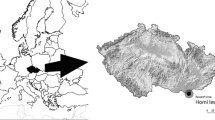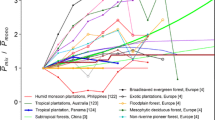Abstract
Trees are taller than shrubs, grasses, and herbs. What is the disadvantage of being tall so that trees are restricted to warmer regions than low stature life forms? This article offers a brief review of the current state of biological treeline theory, and then explores the significance of tallness from a carbon balance, freezing resistance, and microclimatological perspective. It will be argued that having of a woody stem is neither a burden to the carbon balance nor does it add to the risk of freezing damage. The physiological means of trees to thrive in cold climates are similar to small stature plants, but due to their size, and, thus, closer aerodynamic coupling to air circulation, trees experience critically low temperatures at lower elevation and latitude than smaller plants. Hence, trees reach a limit at treeline for physical reasons related to their stature.




Similar content being viewed by others
References
Alvarez-Uria, P., and C. Körner. 2007. Low temperature limits of root growth in deciduous and evergreen temperate tree species. Functional Ecology 21: 211–218.
Bernoulli, M., and C. Körner. 1999. Dry matter allocation in treeline trees. Phyton 39: 7–12.
Björklund, L. 1999. Identifying heartwood-rich stands or stems of Pinus sylvestris by using inventory data. Silva Fennica 33: 119–129.
Bosshard, H.H. 1984. Holzkunde, vol. II. Basel: Birkhäuser.
Callaghan, T.V., R.M.M. Crawford, M. Eronen, A. Hofgaard, S. Payette, W.G. Rees, O. Skre, B. Sveinbjörnsson, et al. 2002. The dynamics of the tundra-taiga boundary: An overview and suggested coordinated and integrated approach to research. AMBIO 12: 3–5.
Germino, M.J., and W.K. Smith. 1999. Sky exposure, crown architecture, and low-temperature photoinhibition in conifer seedlings at alpine treeline. Plant, Cell and Environment 22: 407–415.
Gervais, B.R., and G.M. MacDonald. 2000. A 403-year record of July temperatures and treeline dynamics of Pinus sylvestris from the Kola Peninsula, northwest Russia. Arctic, Antarctic, and Alpine Research 32: 295–302.
Gould, P.J., and C.A. Harrington. 2008. Extending sapwood—Leaf area relationships from stems to roots in Coast Douglas-fir. Annals of Forest Science. doi:10.1051/forest:2008067.
Grace, J. 1988. The functional significance of short stature in montane vegetation. In Plant form and vegetation structure, ed. M.J.A. Werger, P.J.M. Van der Aart, H.J. During, and J.T.A. Verhoeven, 201–209. The Hague: SPB Academic Publishing.
Grace, J., S.J. Allen, and C. Wilson. 1989. Climate and the meristem temperatures of plant communities near the tree-lines. Oecologia 79: 198–204.
Harsch, M.A., P.E. Hulme, M.S. McGlone, and R.P. Duncan. 2009. Are treelines advancing? A global meta-analysis of treeline response to climate warming. Ecology Letters 12: 1040–1049.
Hijmans, R.J., S.E. Cameron, J.L. Parra, P.G. Jones, and A. Jarvis. 2005. Very high resolution interpolated climate surfaces for global land areas. International Journal of Climatology 25: 1965–1978.
Hoch, G., and C. Körner. 2003. The carbon charging of pines at the climatic treeline: A global comparison. Oecologia 135: 10–21.
Hoch, G., and C. Körner. 2011. Global patterns of mobile carbon stores in trees at high elevation treeline. Global Ecology and Biogeography. doi:10.1111/j.1466-8238.2011.00731.x.
Hoch, G., A. Richter, and C. Körner. 2003. Non-structural carbohydrates in temperate forest trees. Plant Cell Environ 26: 1067–1081.
Holtmeier, F.-K. 2009. Mountain timberlines. Ecology, patchiness, and dynamics. Berlin: Springer.
Huber, B., and G. Prütz. 1938. Über den Anteil von Fasern, Gefässen und Parenchym am Aufbau verschiedener Hölzer. Holz als Roh- und Werkstoff 1: 377–381.
Knapic, S., and H. Pereira. 2005. Within-tree variation of heartwood and ring width in maritime pine (Pinus pinaster Ait.). Forest Ecology and Management 210: 81–89.
Körner, C. 1994. Biomass fractionation in plants: A reconsideration of definitions based on plant functions. In A whole plant perspective on carbon–nitrogen interactions, ed. J. Roy, and E. Garnier, 173–185. The Hague: SPB Academic Publishing.
Körner, C. 1999. Alpine plants: Stressed or adapted? In Physiological plant ecology, ed. M.C. Press, J.D. Scholes, and M.G. Barker, 297–311. Oxford: Blackwell.
Körner, C. 2003. Alpine plant life. Berlin: Springer.
Körner, C. 2007. Climatic treelines: Conventions, global patterns, causes. Erdkunde 61: 315–324.
Körner, C. 2008. Winter crop growth at low temperature may hold the answer for alpine treeline formation. Plant Ecology and Diversity 1: 3–11.
Körner, C. 2012. Alpine treelines. Basel: Springer.
Körner, C., and J. Paulsen. 2004. A world-wide study of high altitude treeline temperatures. Journal of Biogeography 31: 713–732.
Körner, C., J. Paulsen, and E.M. Spehn. 2011. A definition of mountains and their bioclimatic belts for global comparison of biodiversity data. Alpine Botany 121: 73–78.
Kullman, L. 1990. Dynamics of altitudinal tree-limits in Sweden: A review. Norsk Geologisk Tidsskrift 44: 103–116.
Kullman, L. 2007. Tree line population monitoring of Pinus sylvestris in the Swedish Scandes, 1973–2005: Implications for tree line theory and climate change ecology. Journal of Ecology 95: 41–52.
Larcher, W. 1985. Winter stress in high mountains. In Establishment and tending of subalpine forest: Research and management, ed. H. Turner, and W. Tranquillini. Berichte der Eidgenössischen Anstalt für das forstliche Versuchswesen 270: 11–20.
Matyssek, R. 1985. Der Kohlenstoff-, Wasser-, und Nahrstoffhaushalt der wechselgrünen und immergrünen Koniferen Lärche, Fichte, Kiefer. PhD thesis. Bayreuth, Germany: University of Bayreuth.
Matyssek, R., G. Wieser, K. Patzner, H. Blaschke, and K.H. Haberle. 2009. Transpiration of forest trees and stands at different altitude: Consistencies rather than contrasts? European Journal of Forest Research 128: 579–596.
Mayr, S. 2007. Limits in water relations. In Trees at their upper limit, ed. G. Wieser, and M. Tausz, 145–162. Berlin: Springer.
Münster-Swendsen, M. 1987. Index of vigour in Norway spruce (Picea abies Karst.). Journal of Applied Ecology 24: 551–561.
Oren, R., E.-D. Schulze, R. Matyssek, and R. Zimmermann. 1986. Estimating photosynthetic rate and annual carbon gain in conifers from specific leaf weight and leaf biomass. Oecologia 70: 187–193.
Paulsen, J., U.M. Weber, and C. Körner. 2000. Tree growth near treeline: Abrupt or gradual reduction with altitude? Arctic, Antarctic, and Alpine Research 32: 14–20.
Rossi, S., A. Desauriers, T. Anfodillo, and V. Carraro. 2007. Evidence of threshold temperatures for xylogenesis in conifers at high altitudes. Oecologia 152: 1–12.
Sakai, A., and W. Larcher. 1987. Frost survival of plants. Responses and adaptation. Ecological Studies 62. Berlin: Springer.
Sakai, A., and S. Okada. 1971. Freezing resistance of conifers. Silvae Genetica 20: 91–97.
Sala, A., W. Fouts, and G. Hoch. 2011. Carbon storage in trees: Does relative carbon supply decrease with tree size? In Size- and age-related changes in tree structure and function (Tree Physiology 4), ed. F. C. Meinzer, B. Lachenbruch and T. E. Dawson, 287–306. Berlin: Springer. doi:10.1007/978-94-007-1242_11.
Schönenberger, W. 2001. Cluster afforestation for creating diverse mountain forest structures—A review. Forest Ecology and Management 145: 121–128.
Schulze, E.-D., J. Cermak, R. Matyssek, M. Penka, R. Zimmermann, F. Vasicek, W. Gries, and J. Kucera. 1985. Canopy transpiration and water fluxes in the xylem of the trunk of Larix and Picea trees—A comparison of xylem flow, porometer and cuvette measurements. Oecologia 66: 475–483.
Sellin, A. 1994. Sapwood-heartwood proportion related to tree diameter, age and growth rate in Picea abies. Canadian Journal of Forest Research 24: 1022–1028.
Smith, W.K., M.J. Germino, T.E. Hancock, and D.M. Johnson. 2003. Another perspective on altitudinal limits of alpine timberlines. Tree Physiology 23: 1101–1112.
Squeo, A., F. Rada, A. Azocar, and G. Goldstein. 1991. Freezing tolerance and avoidance in high tropical Andean plants: Is it equally represented in species with different plant height? Oecologia 86: 378–382.
Sterck, F.J., R. Zweifel, U. Sass-Klaassen, and Q. Chowdhury. 2008. Persisting soil drought reduces leaf specific conductivity in Scots pine (Pinus sylvestris) and pubescent oak (Quercus pubescent). Tree Physiology 28: 529–536.
Stöcklin, J., and C. Körner. 1999. Recruitment and mortality of Pinus sylvestris near the nordic treeline: The role of climatic change and herbivory. Ecological Bulletins 47: 168–177.
Sveinbjörnsson, B., A. Hofgaard, and A. Lloyd. 2002. Natural causes of the tundra-taiga boundary. AMBIO 12: 23–29.
Tranquillini, W. 1979. Physiological ecology of the Alpine Timberline. Tree existence at high altitudes with special references to the European Alps. Ecological Studies 31. Berlin: Springer.
Troll, C. 1973. The upper timberlines in different climatic zones. Arctic and Alpine Research 5: A3–A18.
von Humboldt, A., and A. Bonpland. 1807. Ideen zu einer Geographie der Pflanzen nebst einem Naturgemälde der Tropenländer. Tübingen: F.G. Cotta; Paris: F. Schoell.
Wieser, G. 1997. Carbon dioxide gas exchange of cembran pine (Pinus cembra) at the alpine timberline during winter. Tree Physiology 17: 473–477.
Wieser, G., and M. Bahn. 2004. Seasonal and spatial variation of woody tissue respiration in a Pinus cembra tree at the alpine timberline in the central Austrian Alps. Trees - Structure and Function 18: 576–580.
Wieser, G., and M. Tausz. 2007. Trees at their upper limit—Treelife limitation at the Alpine Timberline. Dordrecht: Springer.
Würth, M.K.R., S. Pelaez-Riedl, S.J. Wright, and C. Körner. 2005. Non-structural carbohydrate pools in a tropical forest. Oecologia 143: 11–24.
Zhu, Y., R.T.W. Siegwolf, W. Durka, and C. Körner. 2010. Phylogenetically balanced evidence for structural and carbon isotope responses in plants along elevational gradients. Oecologia 162: 853–863.
Acknowledgments
With great pleasure I dedicate this article to Professor Terry Callaghan as part of the festschrift at the occasion of his retirement from directorship at the Abisko Research Station. Much of the treeline theory presented here developed during my sabbatical stays at the station. I thank Jens Paulsen for providing his unpublished statistics on global treeline climatology and Susanna Riedl for the artwork. This paper developed while funded by the European Research Council, advanced Grant 233399, TREELIM.
Author information
Authors and Affiliations
Corresponding author
Rights and permissions
About this article
Cite this article
Körner, C. Treelines Will be Understood Once the Functional Difference Between a Tree and a Shrub Is. AMBIO 41 (Suppl 3), 197–206 (2012). https://doi.org/10.1007/s13280-012-0313-2
Published:
Issue Date:
DOI: https://doi.org/10.1007/s13280-012-0313-2




